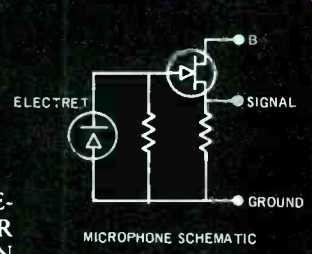
By Roland H Reiss
Mount this miniature integrated circuit condenser transducer into a time-worn microphone housing and add a new dimension to your live tape recordings.

---Electret signal ground microphone schematic.
A prime example of man's inhumanity to man is to provide him with a wonderful extended range tape recorder and include an inexpensive microphone to use for recordings.
Most inexpensive microphones crop off a small band of frequencies on the low end of the audio range and an even greater band of high frequencies.
The resulting recordings made with these microphones leave much to be desired by the serious minded audiophile. Music recordings that lack the high frequency transients and low overtones, sound lifeless and flat.
No recorder can overcome this handicap imposed on it by an inferior microphone.
In search for a better microphone, it doesn't take long to discover that prices are directly proportional to the increased frequency response. The higher the fi, the higher the price. The condenser microphone is capable of recording sounds well above the range of most recorders but its cost has been high enough to keep it out of the amateur's hands.
A recent development in microphones has been the electret condenser microphone. This microphone has most of the fine qualities that the standard condenser microphone has, but has eliminated the need for the high voltage used to polarize the diaphragm of the standard condenser microphone.
This does away with the bulky high voltage power supply. The electret's diaphragm is pre-polarized by subjecting a thin metalized plastic film to a high voltage flux field and raising the temperature of the plastic close to the melting point. Cooling the plastic film slowly while it remains in the flux field results in a permanently polarized plastic film that is used for the diaphragm of the microphone. By placing this charged diaphragm close to the gate lead of a field effect transistor, a solid state electret microphone is created.
The operating principles of this electret condenser microphone are fairly simple. The metalized plastic diaphragm, vibrating with the sound pressure close to the FET gate, acts as a charged capacitor and converts the sound vibrations into voltage variations. The varying voltage signal is taken from the low impedance point of the FET source follower circuit. The extremely high impedance of the electret element is thus reduced to a lower impedance capable of working directly into most high quality recorder preamps.
Browsing through the classified section of AUDIO recently I came across an ad for an electret microphone module which costs only $13.50. So I sent for one and I must say I have been very pleased with the performance.
The unit is combined with an FET preamplifier and is housed in a tiny package measuring slightly more than a quarter of an inch square and less than three sixteenths of an inch thick. It is basically a complete microphone in itself, needing only a small penlite cell to power it and an output cable to transfer the signal output to the recorder.
The current drain of the package is so small (30 microamps typical), that no provision need be made for an on-off switch. Ten thousand hours of battery life is common.
This tiny microphone module may be used as is by building it directly into the front panel of a tape recorder to provide a/permanent high quality sound pick-up for live recordings. Small as it is, it can easily be mounted inside a discarded microphone housing, converting it into a hand held mike. When mounting the module inside a microphone housing, it is suggested that a pop filter made from 1/2 " to 1 " of open grained foam plastic be placed between the front grill and the front of the module. This type of foam is common, and is often used as packing material for shipping fragile instruments. A simple method of mounting the module after it is wired, is to sandwich it between two pieces of foam plastic cut to proper size to fit inside the microphone housing. The two pieces of foam act as a pop filter and shock mounting.
With a little ingenuity, any time worn microphone can become a professional quality condenser microphone.
With the development of these small electret condenser microphone modules, professional sounding recordings are easy to get and at a cost within the range of any recording enthusiast. This miniature integrated circuit transducer, model 5333, is available from: Electronics Enterprises, 3305 Pestana Way, Livermore, California 94550.
I agree with Mr. Reiss that microphones supplied with recorders are often of poor quality. On the other hand good quality microphones can be bought quite cheaply.
For instance, there is the Sony ECM 18 electret type around $20 and the TEAC dynamic MC-106L at $18. However, I must say the specifications of the 5333 look good and its small size gives a lot of scope to the experimenter. We hope to review one of these modules in the near future.
-ED.
Also see:
Part 2: The Compleat Microphone Evaluation--An Update (Sept. 1978)
The Compleat Microphone Evaluation (Apr. 1977)
(Audio magazine, May 1973)
= = = =